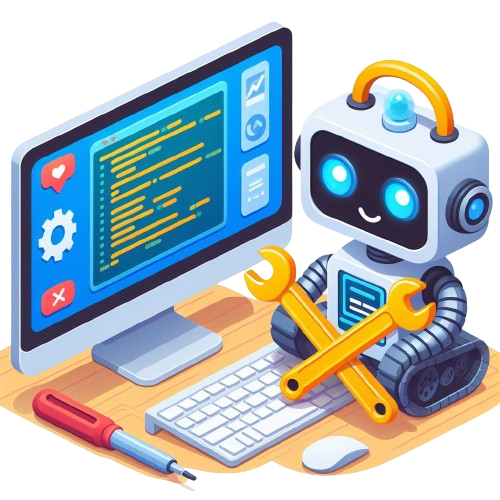✨Quick Answer:
Standard method:
- Identify the problem you are looking solution for.
- Collect the right data for training your AI model.
- Choose the right platform and programming language.
- Create algorithms that will be able to analyze data.
- Train the AI model to enable accurate work of your AI tool.
- Deploy and monitor your AI to ensure it is working correctly.
Alternative method:
- Once you identified the problem, see if solving that with AI API (like Open AI API) is feasible.
- If yes, then you can skip training your own AI model and use third-party API instead.
- In most cases, this method would be much faster.
Building Your Own AI Tool
Brief Overview
Making your own AI tool can be a challenging but rewarding experience. You can create a custom solution that solves a specific problem or enhances your personal or professional project.
You will face some decision-making matters like choosing the right platform, gathering enough data, fine-tuning, and deploying your AI. Fortunately, there are many resources available now to help you build your AI tool without knowing how to code.
Creating your own AI can be a fun and fulfilling journey, as long as you are aware of the benefits and challenges along the way.
Steps for Making Your AI Tool
To succeed in building your AI tool, you should accurately implement the following major steps. Let’s take a closer look:
1. Identify the Problem
The first step in building an AI tool is to identify the problem you want to solve. This could be anything from automating a task and improving your customer service to predicting future trends.
2. Collect the Right Data
Once you have identified the problem, you need to collect the right data to train your AI model. This data should be relevant to the problem you are trying to solve. The data required falls into two categories – structured and unstructured.
| Structured data | Data with a predefined format and organization, making it easily searchable and analyzable. | Dates, phone numbers, product SKUs, star ratings, etc. |
| Unstructured data | Data that has no predefined format or organization, and makes it difficult to search and analyze. | Text, images, videos, audio, social media posts, etc. |
3. Choose the Right Platform
There are many platforms available for building AI tools. These so-called development framework platforms enable users to design, write, train, and debug AI systems. You need to choose the one that best suits your needs.
Here is the list of major and solid AI-building platforms, tools and frameworks that you can use:
- Microsoft Azure
- PyTorch
- Theano
- Caffe
- Scikit-learn
- TensorFlow
- LangChain
- Keras
- Open AI
- IBM Watson
It is worth noting that many of these platforms are open-source frameworks and hence cost-effective. Moreover, they usually have active and knowledgeable user communities.
4. Pick a Programming Language
Now you need to choose the best-suited programming language. There are four key programming languages fit for AI systems: Python, R, Java, and C++. Some of them will be more suitable for your AI than others based on the main goal of the AI tool.
| Language | Best suited for |
| Python | Data analysis, machine learning, deep learning, natural language processing, computer vision, and web development. Widely regarded as one of the best programming languages for AI development. |
| R | Data science, data visualization, and statistical analysis. Ideal for data-centric AI applications. |
| Java | General-purpose programming language. Good for distributed computing, big data, natural language processing, and search engines. |
| C++ | Widely used for system and game development. Good for high-performance computing, computer vision, and robotics. |
5. Create Algorithms
After the steps above, you need to create algorithms that can process the data and implement the required task. An algorithm is a set of instructions that tells a computer how to solve a problem or perform a task.
AI Algorithm is a type of algorithm that uses artificial intelligence techniques, such as machine learning, deep learning, NLP, computer vision, etc., to learn from data and perform complex operations.
6. Train Your Algorithms
Once you have created your algorithms, you need to train your AI model using the data you have collected. This will help your AI tool carry out the needed operations more accurately. To improve the accuracy, you may have to gather additional data.
Naturally, the algorithm training process will involve testing and fine-tuning of your AI. It will be necessary to tweak algorithms to enhance its relaibility.
7. Deploy and Monitor Your AI Tool
Finally, after successful training and testing, you need to deploy your AI tool and keep monitoring its performance to ensure that it is working correctly. Deployment involves making it available for use in a website, an application, or other environments.
While monitoring your AI tool you will track its performance and behavior and ensure that it meets your expectations. This will typically involve collecting and analyzing metrics, logs, and feedback, and detecting and resolving any issues or errors.
🚨 Check also ⬇️
– How AI Can Benefit Your Business (7 Concrete Ways)
– How To Make Money with AI (5 Realistic Options)
Brief Summary
Nowadays, there are numerous AI tools and applications solving a multitude of various issues. Yet, you might still struggle to find the right one for your specific needs. That alone can motivate you to create your own customized AI tool.
Overall, this article provides a basic grasp and very high level overview of how to make your own AI tool.

